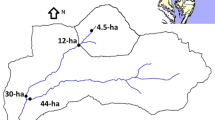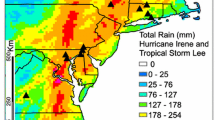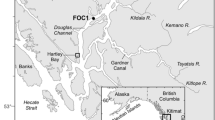Abstract
This study compared the storm event patterns, sources, and flow paths for particulate (POC) and dissolved organic carbon (DOC <0.45 μm) with a special focus on responses during large storm events. The study was conducted in a 12 ha forested catchment in the mid-Atlantic, Piedmont region of USA. A total of 14 storm events were sampled over a 16-month period (September 2010 to December 2011) including large, intense storms (precipitation >150 mm) associated with two hurricanes—Nicole (2010) and Irene (2011). Storm-event concentrations for suspended sediment (SS), POC and DOC varied between 10–7589, 0.05–252, and 0.7–18.3 mg L−1, respectively. Within-event POC concentrations continued to increase for the large hurricane storms whereas DOC displayed a dilution at peak streamflow discharge. Flow-weighted mean POC concentrations decreased for closely spaced, successive storm events whereas no such decrease was observed for DOC. These results suggest that there are important differences in the supply and transport (leaching rates and kinetics) for POC and DOC which occur at different temporal scales. The % POC content of SS was highest for the summer events. Summer events also registered a sharper increase in DOC with stream discharge and then a decline for peak flow, suggesting critical seasonal controls on storm-event POC and DOC responses. End-member mixing analysis revealed POC is transported with surface runoff while DOC is transported by saturation overland flow and rising groundwater into the soil horizons. A mixing model for sediment sources failed to identify key end-members but event mixing patterns revealed near-stream sources for small events and more distal, upland sediment sources for large and intense storms. This study highlights the need to better understand POC and DOC responses in headwater catchments especially for the large, intense, storm events that are predicted to increase in intensity with climate change.











Similar content being viewed by others
References
Alexandrov Y, Laronne JB, Reid I (2003) Suspended sediment transport in flash floods of the semiarid northern Negev. IAHS Publications, Israel, pp 346–352
Alvarez-Cobelas M, Angeler D, Sánchez-Carrillo S, Almendros G (2012) A worldwide view of organic carbon export from catchments. Biogeochemistry 107:275–293
Bass AM, Bird MI, Liddell MJ, Nelson PN (2011) Fluvial dynamics of dissolved and particulate organic carbon during periodic discharge events in a steep tropical rainforest catchment. Limnol Oceanogr 56:2282–2292
Battin TJ, Kaplan LA, Findlay S, Hopkinson CS, Marti E, Packman AI, Newbold JD, Sabater F (2008) Biophysical controls on organic carbon fluxes in fluvial networks. Nat Geosci 1:95–100
Bender MA, Knutson TR, Tuleya RE, Sirutis JJ, Vecchi GA, Garner ST, Held IM (2010) Modeled impact of anthropogenic warming on the frequency of intense Atlantic hurricanes. Science 327:454–458
Borken W, Matzner E (2009) Reappraisal of drying and wetting effects on C and N mineralization and fluxes in soils. Glob Change Biol 15:808–824
Brooks PD, O’Reilly CA, Diamond SA, Campbell DH, Knapp R, Bradford D, Corn PS, Hossack B, Tonnessen K (2005) Spatial and temporal variability in the amount and source of dissolved organic carbon: implications for UV exposure in amphibian habitats. Ecosystems 8:478–487
Buffle J (1984) Natural organic matter and metal-organic interactions in aquatic systems. Met Ions Biol Syst 18:165–221
Butman D, Raymond PA (2011) Significant efflux of carbon dioxide from streams and rivers in the United States. Nat Geosci 4:839–842. doi:10.1038/ngeo1294
Chow AT, Dahlgren RA, Zhang Q, Wong PK (2008) Relationships between specific ultraviolet absorbance and trihalomethane precursors of different carbon sources. J Water Supply Res Technol 57(7):471–480
Cole J (2013) Freshwater in flux. Nat Geosci 6(1):13–14. doi:10.1038/ngeo1696
Cole J, Prairie Y, Caraco N, McDowell W, Tranvik L, Striegl R, Duarte C, Kortelainen P, Downing J, Middelburg J (2007) Plumbing the global carbon cycle: integrating inland waters into the terrestrial carbon budget. Ecosystems 10:172–185
Cory RM, McKnight DM, Chin Y, Miller P, Jaros C (2007) Chemical characteristics of fulvic acids from Arctic surface waters: microbial contributions and photochemical transformations. J Geophys Res 112:G04S51. doi:10.1029/2006JG000343
Coynel A, Etcheber H, Abril G, Maneux E, Dumas J, Hurtrez JE (2005) Contribution of small mountainous rivers to particulate organic carbon input in the Bay of Biscay. Biogeochemistry 74:151–171
Crisp DT, Robson S (1979) Some effects of discharge upon the transport of animals and peat in a north Pennine headstream. J Appl Ecol 16:721–736
Delaware Environmental Observing Station (DEOS) (2012). http://www.deos.udel.edu/ Accessed 30 Oct 2012
Dhillon G (2012) Comparison of particulate and dissolved organic carbon exports from forested piedmont catchments. Master’s Thesis, University of Delaware, Newark, DE
Dhillon G, Inamdar S (2013) Extreme storms and changes in particulate and dissolved organic carbon in runoff: entering uncharted waters? Geophys Res Lett 40:1322–1327. doi:10.1002/grl.50306
Driscoll CT, Johnson NM, Likens GE, Feller MC (1988) Effects of acidic deposition on the chemistry of headwater streams: a comparison between Hubbard Brook, New Hampshire, and Jamieson Creek, British Columbia. Water Resour Res 24:195–200
Evans C, Davies TD (1998) Causes of concentration/discharge hysteresis and its potential as a tool for analysis of episode hydrochemistry. Water Resour Res 34:129–137
Fellman JB, Hood E, Edwards RT, D’Amore DV (2009) Changes in the concentration, biodegradability, and fluorescent properties of dissolved organic matter during stormflows in coastal temperate watersheds. J Geophys Res 114:G01021
Herczeg AL, Broecker WS, Anderson RF, Schiff SL, Schindler DW (1985) A new method for monitoring temporal trends in the acidity of fresh waters. Nature 315:133–135
Hood E, Gooseff MN, Johnson SL (2006) Changes in the character of stream water dissolved organic carbon during flushing in three small watersheds, Oregon. J Geophys Res 111:G01007
Hooper RP (2003) Diagnostic tools for mixing models of stream water chemistry. Water Resour Res 39:1055
Hope D, Billett M, Cresser M (1994) A review of the export of carbon in river water: fluxes and processes. Environ Pollut 84:301–324
Hrudey SE (2009) Chlorination disinfection by-products, public health risk tradeoffs and me. Water Res 43:2057–2092
Inamdar SP (2011) The use of geochemical mixing models to derive runoff sources and hydrologic flow paths in watershed studies. In: Levia D, Carlyle-Moses D, Tanaka T (eds) Forest hydrology and biogeochemistry: synthesis of research and future directions. Springer, New York
Inamdar SP, Mitchell MJ (2007) Storm event exports of dissolved organic nitrogen (DON) across multiple catchments in a glaciated forested watershed. J Geophys Res 112:G02014
Inamdar SP, O’Leary N, Mitchell MJ, Riley JT (2006) The impact of storm events on solute exports from a glaciated forested watershed in western New York, USA. Hydrol Process 20:3423–3439
Inamdar SP, Singh S, Dutta S, Levia D, Mitchell M, Scott D, Bais H, McHale P (2011) Fluorescence characteristics and sources of dissolved organic matter for stream water during storm events in a forested mid-Atlantic watershed. J Geophys Res 116:G03043
Inamdar SP, Finger N, Singh S, Mitchell M, Levia D, Bais H, Scott D, McHale P (2012) Dissolved organic matter (DOM) concentration and quality in a forested mid-Atlantic watershed, USA. Biogeochemistry 108:1–22
Inamdar SP, Dhillon G, Singh S, Dutta S, Levia DF, Mitchell MJ, Van Stan J, Scott D, McHale P (2013) The controls of end-member chemistry and hydrologic conditions on the temporal patterns of runoff in a forested, Piedmont catchment. Water Resour Res 49:1828–1844. doi:10.1002/wrcr.20158
Jeong JJ, Bartsch S, Fleckenstein JH, Matzner E, Tenhunen JD, Lee SD, Park SK, Park JH (2012) Differential storm responses of dissolved and particulate organic carbon in a mountainous headwater stream, investigated by high-frequency, in situ optical measurements. J Geophys Res 117:G03013
Johnson MS, Lehmann J, Selva EC, Abdo M, Riha S, Couto EG (2006) Organic carbon fluxes within and streamwater exports from headwater catchments in the southern Amazon. Hydrol Process 20:2599–2614
Jung BJ, Lee HJ, Jeong JJ, Owen J, Kim B, Meusburger K, Alewell C (2012) Storm pulses and varying sources of hydrologic carbon export from a mountainous watershed. J Hydrol 440–441:90–101
Karl TR, Melillo JM, Peterson TC, Hassol SJ (2009) Global climate change impacts in the United States. Cambridge University Press, Cambridge
Kim S, Kim J, Kim K (2010) Organic carbon efflux from a deciduous forest catchment in Korea. Biogeosciences 7:1323–1334
Levia D, Van Stan J, Mage S, Kelley-Hauske P (2010) Temporal variability of stemflow volume in a beech-yellow poplar forest in relation to tree species and size. J Hydrol 380:112–120
Lundquist E, Jackson L, Scow K (1999) Wet–dry cycles affect dissolved organic carbon in two California agricultural soils. Soil Biol Biochem 31:1031–1038
Luo J, Ma M, Liu C, Zha J, Wang Z (2009) Impacts of particulate organic carbon and dissolved organic carbon on removal of polycyclic aromatic hydrocarbons, organochlorine pesticides, and nonylphenols in a wetland. J Soils Sediments 9:180–187
Maryland State Climatologist Office Data Page. http://metosrv2.umd.edu/~climate/cono/norm.html. Accessed 21 June 2013
Ni HG, Lu FH, Luo XL, Tian HY, Zeng EY (2008) Riverine inputs of total organic carbon and suspended particulate matter from the Pearl River Delta to the coastal ocean off South China. Mar Pollut Bull 56:1150–1157
Oeurng C, Sauvage S, Coynel A, Maneux E, Etcheber H, Sánchez-Pérez JM (2011) Fluvial transport of suspended sediment and organic carbon during flood events in a large agricultural catchment in southwest France. Hydrol Process 25:2365–2378
Pawson R, Lord D, Evans M, Allott T (2008) Fluvial organic carbon flux from an eroding peatland catchment, southern Pennines, UK. Hydrol Earth Syst Sci Discuss 12:625–634
Pawson R, Evans M, Allott T (2012) Fluvial carbon flux from headwater peatland streams: significance of particulate carbon flux. Earth Surf Process Landf 37:1203–1212
Raymond PA, Saiers JE (2010) Event controlled DOC export from forested watersheds. Biogeochemistry 100:197–209
Rovira A, Batalla RJ (2006) Temporal distribution of suspended sediment transport in a Mediterranean basin: the Lower Tordera (NE Spain). Geomorphology 79:58–71
Townsend-Small AT, McClain ME, Hall B, Noguera JL, Llerena CA, Brandes JA (2008) Suspended sediments and organic matter in mountain headwaters of the Amazon River: results from a 1-year time series study in the central Peruvian Andes. Geochim Cosmochim Acta 72:732–740
Veyssy E, Etcheber H, Lin R, Buat-Menard P, Maneux E (1999) Seasonal variation and origin of particulate organic carbon in the lower Garonne River at La Reole (southwestern France). Hydrobiologia 391:113–126
Walling DE, He Q (1999) Using fallout lead 201 measurements to estimate soil erosion on cultivated land. Soil Sci Soc Am J 63:1404–1412
Ward AD, Trimble SW (2004) Environmental hydrology. Lewis Publishers, New York
Wiegner TN, Tubal RL, MacKenzie RA (2009) Bioavailability and export of dissolved organic matter from a tropical river during base-and stormflow conditions. Limnol Oceanogr 54:1233
Acknowledgments
The authors would like to acknowledge the support of Delaware Water Resources Center (DWRC) for providing a research assistantship to Gurbir Singh Dhillon for his master’s thesis research. Instrumentation and sampling in the study catchments was funded through an existing grant from the National Science Foundation (NSF, Hydrologic Sciences Program, EAR‐0809205). We also thank Dr. Myron Mitchell’s Biogeochemistry Laboratory at Syracuse for the analyses on water samples and Karen Gartley and the UD Soils Laboratory for the POC analyses. We would like to thank Captain Wayne Suydam and the Fair Hill NRMA staff for providing access to the study site. We also thanks Drs. Tom Sims and Yan Jin for their suggestions and insights during Gurbir’s MS thesis research. We would also like to recognize the support of graduate student colleagues including Shatrughan Singh, Sudarshan Dutta, Rachael Vaicunas and Zhixuan Qin for sample collection and analyses.
Author information
Authors and Affiliations
Corresponding author
Additional information
Responsible Editor: Eran Hood
Rights and permissions
About this article
Cite this article
Dhillon, G.S., Inamdar, S. Storm event patterns of particulate organic carbon (POC) for large storms and differences with dissolved organic carbon (DOC). Biogeochemistry 118, 61–81 (2014). https://doi.org/10.1007/s10533-013-9905-6
Received:
Accepted:
Published:
Issue Date:
DOI: https://doi.org/10.1007/s10533-013-9905-6




